Systems Engineering for Naval Ship Design Evolution
Abstract
:1. Introduction: The Complexity of Warship Design
2. The Design Spiral: Points of Strength and Weakness
- Close process: the interactions with all the stakeholders involved in the design process are not rationally described in the Design Spiral stages and it is not clear when and how their feedback is needed to assess the solution.
- Inappropriate Early Stage Ship Design: the decisional process in the early phases of the ship design is crucial to well define the problem and identify the requirements needed. The requirements identification is taken for granted and it is completely left out of the design process, which uses them as input.
- Lack of a Life-Cycle vision: it considers only the design stage of the ship’s entire life, excluding from the design process the influences of significant phases like overarching architectures, operational life, maintenance, and retirement.
- Linear approach: the naval architectural aspects of the design cannot be adequately structured and represented by flow diagrams like the design spiral. This is due to the process involving closed loops and intuitive leaps, while performance functions are nonlinear and often discontinuous. In addition, inequalities are more common than equations in this context. The looping, nonlinear, and discontinuous nature of the design process creates challenges not only for representing it using the design spiral but also for computer-based systems widely used for achieving balanced solutions through rapid iterations [19].
3. Overview of Systems Engineering Approach
- Improving the quality of the design.
- Controlling costs throughout the entire life cycle framework.
- Enhancing interaction among stakeholders.
- Measures of Effectiveness (MOEs)“The “operational” measures of success that are closely related to the achievement of the mission or operational objective being evaluated, in the intended operational environment under a specified set of conditions; i.e., how well the solution achieves the intended purpose.” INCOSE
- Measures of Performance (MOPs)“The measures that characterize physical or functional attributes relating to the system operation, measured or estimated under specified testing and/or operational environment conditions.” INCOSE
- Technical Performance Measures (TPMs)“TPMs measure attributes of a system element to determine how well a system or system element is satisfying or expected to satisfy a technical requirement or goal.” INCOSE
- Key Performance Parameters (KPPs)“A critical subset of the performance parameters representing those capabilities and characteristics so significant that failure to meet the threshold value of performance can cause for the concept or system selected to be reevaluated or the project to be reassessed or terminated.” INCOSE
4. A Proposal for the Integration of the V-Model and the Design Spiral
- -
- Definition of technical features starting from needs (problem domain)
- -
- Subsequent development of details for the system identified as a solution (solution domain)
- Platform: it refers to the ship itself, including its hull, superstructure, propulsion systems, sensors, and other fundamental components. It is the physical vessel that serves as a foundation for carrying and deploying various types of payloads.
- Payload: it refers to the specific equipment, weaponry, sensors, and systems that are installed onboard the ship to carry out its mission operational objectives. For instance, they can be weapons like missiles, guns, torpedoes, or sensors like radar, sonar, or communication systems.
- Equipment selection: The selection of the systems/equipment that are necessary for the naval ship mission.
- Topside: This is where many key components are located along the ship length and it plays a crucial role in the ship’s functionality and combat capabilities. It involves the correct positioning of the payload systems with respect to each other, considering possible interferences between systems.
- EME: Electromagnetic Environment Effects refers to the impact of electromagnetic radiation, including radiofrequency emissions and other forms of electromagnetic energy, on the operation and performance of electronic systems and equipment on board a warship. Considerations on EME are critical to ensure the proper functioning and protection of electronic systems and equipment on board and to maintain operational effectiveness in a potentially hostile electronic warfare environment
- Equipment thermal dissipation: This refers to the management and control of heat generated by the various electronic and electrical equipment on board the warship, which is essential to effectively dissipate to ensure the reliable and safe functioning of these systems.
- Blast and FOD: Blast refers to the shock wave and pressure generated by the detonation of explosive devices. It is a significant concern in naval warfare, as blast effects can cause severe damage to the ship and its crew. Thus, warships are designed and equipped to withstand or mitigate the effects of blasts making use of reinforced hulls, blast-resistant compartments, and other protective measures. FOD (Foreign Object Debris or Foreign Object Damage) refers to any foreign object, substance, or debris that can enter or damage a warship’s systems, equipment, or machinery, potentially leading to equipment malfunction or damage. FOD considerations are crucial for maintenance and operation activities.
- CS LAN/NAV LAN: Combat System LAN (CS LAN) is a network dedicated to supporting the ship’s combat and weapons systems, which is used for coordinating and controlling the ship’s offensive and defensive capabilities, such as missile launch systems, gun mounts, radar, and other combat-related sensors and systems. Navigation LAN (NAV LAN) is a network established for the ship’s navigation and general ship management purposes. It typically includes navigation sensors, charts and mapping systems, GPS equipment, and communication systems necessary for the ship’s navigation and coordination with other vessels. These LANs are separate and distinct to ensure that combat systems and navigation functions are segregated for security and operational reasons, so it is necessary to well define the cable passage and positioning.
5. Conclusions
Author Contributions
Funding
Data Availability Statement
Conflicts of Interest
Appendix A
| Ship Capability | Elemental Capability | Naval Intent | Satisfaction Level | |
|---|---|---|---|---|
| BUOYANCY | BASE BUOYANCY | Ability to sustain the weight of onboard equipment, person and consumables in intact state | 0 | Buoyancy sufficient for Platform and necessary Payload |
| 1 | Draft suitable for intended operational waters and harbors/suitable for propeller immersion/suitable for slamming avoidance | |||
| BUOYANCY RESERVE | Ability to sustain the weight of non-organic onboard loads or flooding | 0 | Buoyancy sufficient for end-of-life load condition | |
| 1 | Possible change of weight with reference to systems renewal against obsolescence | |||
| 2 | Possible change of weight with reference to operability by different modular units onboard | |||
| 3 | Reserve of buoyancy compatible with survivability of the ship in damaged condition | |||
| 4 | Reserve of buoyancy compatible with navigation in damaged condition | |||
| 5 | Reserve of buoyancy compatible with combat activity in damaged condition | |||
| EVEN KEEL WATERLINE BUOYANCY | Ability to distribute weights in order to maintain the Center of Gravity in line with the Center of Buoyancy | 0 | Suitable trim/heel for smooth operation onboard | |
| 1 | Suitable trim/heel for better hydrodynamic performance (resistance and seakeeping) | |||
| 2 | Suitable trim/heel for propeller immersion and slamming avoidance | |||
| STABILITY | INTACT STABILITY | Ability to resist inclining actions in intact conditions | 0 | Compliance with general criteria for stability |
| 1 | Sufficient stability (roll motion amplitude and accelerations) until Sea State 3 (100% functions) | |||
| 2 | Sufficient stability (roll motion amplitude and accelerations) until Sea State 4 (percentage of degrade function TBD) | |||
| 3 | Sufficient stability (roll motion amplitude and accelerations) until Sea State 5 (percentage of degrade function TBD) | |||
| … | … | |||
| 6 | Compliance with special inclining moments | |||
| DAMAGED STABILITY | Ability to resist to inclining actions after a damaging event | 0 | Compliance with criteria for stability in damaged condition (survivability) | |
| 1 | Residual stability compatible with navigation | |||
| 2 | Residual stability compatible with combat activity | |||
| STRUCTURAL STRENGTH | GLOBAL STRUCTURAL STRENGTH | The ability to resist the stress created by the weight distribution along the ship length, the buoyancy given by the submerged watertight hull, in calm water, and in waves. | 0 | Compliance with Steel water and wave bending moment |
| 1 | Global structural strength compatible with Sea State X | |||
| 2 | Withstand the impact of either a surface/surface missile or a naval gun | |||
| 3 | Withstand an internal blast (temporary overpressure caused by an internal explosion of a missile warhead) | |||
| 4 | Withstand a non-contact underwater explosion | |||
| LOCAL STRUCTURAL STRENGTH | Ability to resist specific local loads | 0 | Compliance with local strength assessment requirements | |
| 1 | Local structural strength compatible with Sea State X | |||
| 2 | Withstand slamming dynamic loads (and relevant whipping at a global level) | |||
| 3 | Withstand an external blast (temporary overpressure caused by an explosion outside the vessel)—superstructures | |||
| 4 | Withstand a certain class of fragments (bodies with mass and speed usually generated by an explosion of a missile warhead or a gunshot) | |||
| POWER GENERATION | PROPULSION POWER GENERATION | Ability to generate the necessary power for the Vessel’s propulsion | 0 | Power for Endurance Speed and Maximum Speed |
| 1 | Power for Endurance Speed with Sea State X | |||
| 2 | Power for Maximum Speed with Sea State X | |||
| EQUIPMENT POWER GENERATION | Ability to generate electrical power for all appliances, such as utilities, combat system, navigation, comm., etc. | 0 | Electrical power for all systems in intact state | |
| 1 | Electrical power to supply X % of systems in specified damaged condition | |||
| EMERGENCY POWER GENERATION | Ability to provide power under emergency or degraded conditions | 0 | No Emergency Power Generation | |
| 1 | Power generation for specified emergency systems onboard (self-defense systems included) | |||
| 2 | Power generation for take-me-home system | |||
| CONTROLLABILITY | PROPULSION | Ability to convert generated power into Vessel’s speed | 0 | Maintain Endurance Speed and Maximum Speed |
| 1 | Maintain Endurance Speed with Sea State X | |||
| 2 | Maintain Maximum Speed with Sea State X | |||
| STEERING | Ability to modify the heading of the Vessel | 0 | Compliance with standard maneuverability requirements | |
| 1 | Route stability in unmanned mode | |||
| 2 | Dynamic positioning level 1 | |||
| 3 | Dynamic positioning level 2 | |||
| COMM. | INTERNAL COMMUNICATIONS | Ability to manage the exchanges of information internally among the Warship components | 0 | Ordinary Public Address |
| 1 | Emergency Public Address | |||
| 2 | LAN (Local Area Network) | |||
| Ship Capability | Elemental Capability | Naval Intent | Satisfaction Level | |
|---|---|---|---|---|
| NAVIGATION | SENSING | Ability to acquire information about the Warship position, heading, motion and attitude, and the operational environment surrounding it | 0 | Acquire information about the position |
| Acquire information about heading | ||||
| Acquire information about speed | ||||
| Acquire information about ship attitude and motion | ||||
| Acquire information about environmental features (wind) | ||||
| Acquire information about environmental features (water depth, current) | ||||
| Acquire information about environmental features (distance from other ships, distance from the coast) | ||||
| 1 | Acquire information about environmental features (waves) | |||
| 2 | Spill oil detection | |||
| ROUTE PLANNING | Ability to plan and establish the Warship route. Wind, waves, currents, and sea ice cover are crucial factors in choosing a route at sea. | 0 | Planning ship routes | |
| 1 | Planning ship routes for low-consumption | |||
| 2 | Planning ship routes with reference to weather conditions | |||
| 3 | Planning ship routes for special purposes | |||
| COMMAND AND CONTROL | MARITIME PICTURE COMPILATION/SITUATION ASSESSMENT | Ability to process the data received from passive and active sensors, from Data Links, and from manual insertion by Operators. | 0 | Maritime Picture Compilation is the Capability to process the data received from passive and active sensors, from Data Links, and from manual insertion by Operators. The scope is to display to the Operator a unique representation of the Real-World Objects (RWOs) around the Warship. Situation Assessment is the Capability to identify and classify, based on a Maritime Picture Compilation, any tracks in the maritime picture as friends or possible threats. Many track functionalities for identification are necessary: initialization, association, coupling, |
| 1 | Data Link | |||
| ENGAGEMENT | 0 | Engagement for single-threat | ||
| 1 | Engagement for multiple threats (manual) | |||
| 2 | Engagement for multiple threats (automatic) | |||
| SUPPORT | Ability to monitor and control the status of organic equipment, including the management of alarms and the control of electromagnetic emissions | 0 | Resource Management is the Capability to monitor and control the status of organic equipment, including the management of alarms and the control of electromagnetic emissions. Data Recording and Analysis is the Capability to store, extract, and process data exchanged among all Warship equipment. Support to Navigation is the Capability to support safe navigation of the Warship through navigation aids management. Mission Planning is the capability to define mission parameters and relevant data for the Warship. Training is the Capability to simulate possible scenarios in which the Warship could be involved in order to support Operator training. | |
| 1 | Post Mission Analysis is the Capability to analyze mission recorded data for the purpose of validating actions taken during the tactical phase, potentially generating new contact data based on discovered missed detection/classification opportunities. | |||
| 2 | Approach Control is the Capability to support aircraft operations, including approach, deck landing and take-off. | |||
| 3 | Support Services is the Capability to provide support services such as mail, intranet, data processing | |||
| 4 | UXV Management is the Capability to manage Unmanned Aerial, Surface, or Underwater Vehicles operations. | |||
| 5 | Air Traffic Control is the capability to direct air traffic in coordination with ATC centers. | |||
| EXTERNAL COMM. | EXTERNAL COMMUNICATIONS | Ability to manage the exchanges of information with other units or land centers to receive data and orders and participate as a force asset | 0 | Safety and distress communication systems, in accordance with IMO regulations |
| 0 | External services for shore and other ships communications in a medium-short range distance | |||
| 1 | External services for shore and other ships communications in a long-range distance | |||
| 2 | External services for communication with subsidiaries assets (unmanned vehicles, helicopters, etc.) | |||
| 2 | Public Service satellite communication (WAN) | |||
| 3 | Tactical Data Link | |||
| 4 | Private/Government satellite communication (WAN) | |||
| 4 | External services for submarine communication | |||
| 4 | External services for underwater communication (acoustic communication system) | |||
| SURVEILLANCE | ABS ABOVE WATER SURVEILLANCE | Ability to detect air-based objects (such as aircraft, or missiles) and surface vessels. | 0 | Surveillance to visual range |
| 1 | Surveillance to the horizon | |||
| 2 | Surveillance beyond the horizon | |||
| UWS UNDER WATER SURVEILLANCE | Ability to detect underwater objects, such as submarines or mines. | 0 | Obstacle avoidance in shallow waters | |
| 1 | Passive UW surveillance | |||
| 2 | Active UW surveillance | |||
| COMBAT | AAW ANTI-AIR WARFARE | Ability to deny the enemy the effective use of threats that originate from air: aircrafts, helicopters, missiles, UAV. | 0 | No AAW capability |
| 1 | Limited surveillance and reconnaissance, and short-range self-defense capabilities (e.g., CIWS/PDMS) | |||
| 2 | Self-defense capabilities (i.e., Inner Layer Defence System (ILDS)) | |||
| 3 | Extended Self-defense capabilities (i.e., Limited Outer Layer Defense System (OLDS)) | |||
| 4 | Area Defense capabilities (i.e., OLDS) | |||
| 5 | Defense against ballistic missile | |||
| ASUW ANTI-SURFACE WARFARE | Ability to deny the enemy the effective use of threats that originate from surface vessels. | 0 | No ASuW capability | |
| 1 | Limited surveillance and reconnaissance, short-range (up to 3 km) self-defense ASuW capability (e.g., 40 mm Guns) | |||
| 2 | Medium range (up to 7.5 km) self-defense ASuW capability (e.g., 76 mm Gun) | |||
| 3 | Extended range (up to 11 km) self-defense ASuW capability | |||
| 4 | Offensive to-the-horizon ASuW capability | |||
| 5 | Offensive over-the-horizon ASuW capability | |||
| ASW ANTI-SUBMARINE WARFARE | Ability to deny the enemy the effective use of threats that originate below the water surface by submarines | 0 | No ASW capability | |
| 1 | Limited self-defensive capabilities against submarine threats (Anti-Ship Torpedo Defense) | |||
| 2 | Self-defensive and offensive capabilities against submarine threats inside own sensors’ range | |||
| 3 | Extended ASW capability at standoff distances (e.g., ASW-capable helicopter) | |||
| 4 | Area ASW Coordination and Offensive capability (long-range sensors, standoff weapons, and ASW capable helicopter) | |||
| ELECTRONIC WARFARE | Ability to deny the enemy the effective use of threats that affect the electromagnetic spectrum: Electronic Attack Measures and Electronic Protection Measures | 0 | No EW capability | |
| 1 | Self-defense EW alarm capability (e.g., warning receivers) | |||
| 2 | EW alarm & analysis capability (e.g., direction finding, classification) | |||
| 3 | On-board Self Defense EW alarm, analysis, and passive CM capability | |||
| 4 | On-board Self Defense EW alarm, analysis, and CM capability (active & passive) | |||
| 5 | On-board Local Area Defense EW Suite capability | |||
| MCM MINE-COUNTERMEASURES | Ability to detect and neutralize above-water and underwater mines or other items | 0 | Reducing the risk of applying all self-protection measures (i.e., degaussing, acoustic silencing, MAS) | |
| 1 | Conduct some specific tasks not considered MCM Operations (e.g., surveys and lead-through) | |||
| 2 | Conduct some MCM Operations limited to Detection, Localization, and Classification of mine-like contacts | |||
| 3 | Conduct some MCM Operations limited to Detection, Localization, Classification, and Identification of mine/NOMBO | |||
| 4 | Conduct limited countermining operations | |||
References
- Andrews, D. A comprehensive methodology for the design of ships (and other complex systems). Proc. R. Soc. A 1998, 454, 187–211. [Google Scholar] [CrossRef]
- Clemens, M. The Characteristics of Complex Systems; New England Complex Systems Institute: Cambridge, MA, USA, 2019. [Google Scholar]
- Papanikolaou, A. A Holistic Approach to Ship Design Volume 1: Optimization of Ship Design and Operation for Life Cycle; Springer: Berlin/Heidelberg, Germany, 2019. [Google Scholar]
- Singer, D.J.; Doerry, N.; Buckley, M.E. What is set based design? Nav. Eng. J. 2009, 121, 31–43. [Google Scholar] [CrossRef]
- Guégan, A.; Rafine, B.; Descombes, L.; Fadiaw, H.; Marty, P.; Corrignan, P. A systems engineering approach to ship design. In Proceedings of the 8th International Conference on Complex Systems Design & Management, Paris, France, 12–13 December 2017. [Google Scholar]
- Fernandez, R.P. A New Approach for Using Cad and Plm Integration. In Proceedings of the International Conference on Computer Applications in Shipbuilding (ICCAS), Yokohama, Japan, 13–15 September 2022. [Google Scholar]
- Matsuo, K. Development of PLM system for precise production planning and production control in shipbuilding. In Proceedings of the International Conference on Computer Applications in Shipbuilding (ICCAS), Yokohama, Japan, 13–15 September 2022. [Google Scholar]
- Andrews, D.J. Simulation and the Design Building Block Approach in the Design of Ships and Other Complex Systems. Proc. R. Soc. A Math. Phys. Eng. Sci. 2006, 462, 3407–3433. [Google Scholar] [CrossRef]
- Evans, J. Basic design concepts. J. Am. Soc. Nav. Eng. 1959, 71, 671–678. [Google Scholar] [CrossRef]
- Watson, D. Practical Ship Design; Elsevier: Amsterdam, The Netherlands, 1998; Volume 1. [Google Scholar]
- Levander, K. Innovative ship design—Can innovative ships be designed in a methodological way. In Proceedings of the 8th International Marine Design Conference—IMDC03, Athens, Greece, 5–8 May 2003. [Google Scholar]
- Papanikolaou, A.; Andersen, P.; Kristensen, H.; Levander, K.; Riska, K.; Singer, D.; Vassalos, D. State of the art on design for X. In Proceedings of the 10th International Marine Design Conference IMDC09, Trondheim, Norway, 16–19 May 2009. [Google Scholar]
- Andrews, D. (Ed.) State of the Art Report on Design Methodology. In Proceedings of the 10th International Marine Design Conference IMDC 2009, Trondheim, Norway, 16–19 May 2009. [Google Scholar]
- Andrews, D. (Ed.) State of the Art Report on Design Methodology. In Proceedings of the 11th International Marine Design Conference IMDC 2012, Glasgow, UK, 11–14 June 2012. [Google Scholar]
- Andrews, D.; Erikstad, S.O. State of the Art Report on Design Methodology. In Proceedings of the 12th International Marine Design Conference IMDC 2015, Tokyo, Japan, 11–14 May 2015. [Google Scholar]
- Andrews, D. The Sophistication of Early Stage Design for Complex Vessels. Trans RINA Part A Int. J. Marit. Eng. 2018, 160. [Google Scholar] [CrossRef]
- Brown, A.; Thomas, M. Reengineering the Naval Ship Concept Design Process; From Research to Reality in Ship Systems Engineering Symposium; ASNE: Alexandria, VA, USA, 1998. [Google Scholar]
- Bruinessen, T.; Hopman, H.; Smulders, F. Towards a Different View on Ship Design: The Development of Ships Observed Through a Social-Technological Perspective. In Proceedings of the ASME 2013 32nd International Conference on Ocean, Offshore and Arctic Engineering, Nantes, France, 9–14 June 2013. [Google Scholar]
- Brown, A. Defining a Warship. Nav. Eng. J. 1986, 98, 31–40. [Google Scholar]
- Walden, D.; Roedler, G.; Forsberg, K.; Hamelin, D.; Shortell, T. Systems Engineering Handbook, 4th ed.; International Council on Systems Engineering; Wiley: Hoboken, NJ, USA, 2015. [Google Scholar]
- Federal Aviation Administration. FAA Systems Engineering Manual; Federal Aviation Administration: Washington, DC, USA, 2014. [Google Scholar]
- Katz, T.; Orr, K.; Wheatcraft, L. Guide to Needs and Requirements; International Council on Systems Engineering Report; INCOSE: San Diego, CA, USA, 2022. [Google Scholar]
- Federal Highway Administration. Systems Engineering for Intelligent Transportation Systems: An Introduction for Transportation Professionals; U.S. Department of Transportation: Washington, DC, USA, 2007. [Google Scholar]
- Roedler, G.; Lockheed, M.; Jones, C.; US ARMY. Technical Measurement—A Collaborative Project of PSM, INCOSE, and Industry; INCOSE—International Council On Systems Engineering: San Diego, CA, USA, 2005. [Google Scholar]
- Andrews, D. Art and science in the design of physically large and complex systems. Proc. R. Soc. A Math. Phys. Eng. Sci. 2012, 468, 891–912. [Google Scholar] [CrossRef]
- Gaspar, H.M.; Ross, A.M.; Rhodes, D.H.; Erikstad, S.O. Handling Complexity Aspects in Conceptual Ship De-sign. In Proceedings of the 11th International Marine Design Conference (IMDC), Glasgow, UK, 11–14 June 2012. [Google Scholar]
- Brown, A.J. Application of Operational Effectiveness Models in Naval Ship concept exploration and design. Cienc. Tecnol. Buques 2013, 7, 9–21. [Google Scholar] [CrossRef]
- Brown, A.J.; Salcedo, J. Multiple-Objective Optimization in Naval Ship Design. Nav. Eng. J. 2003, 115, 49–62. [Google Scholar] [CrossRef]
- Bottero, M.; Gualeni, P. Capability-Based Approach for Naval Ships Design: A Metric Formulation. In Proceedings of the 14th International Marine Design Conference (IMDC 22), Vancouver, BC, Canada, 26–30 June 2022. [Google Scholar]
- Forsberg, K.; Mooz, H. The Relationship of System Engineering to the Project Cycle. In Proceedings of the National Council for Systems Engineering (NCOSE) Conference, Chattanooga, TN, USA, 21–23 October 1991; pp. 57–65. [Google Scholar]
- Bottero, M.; Gualeni, P. Systems Engineering and Ship Design: A synergy for getting the right design and the design right. In Proceedings of the 20th International Conference on Ship & Maritime Research (NAV 22), Genova, Italy, 15–17 June 2022. [Google Scholar]
- Papanikolaou, A. Ship Design: Methodologies of Preliminary Design; Springer: Berlin/Heidelberg, Germany, 2014. [Google Scholar]
- Rawson, K. The Architecture of Marine Systems. IEE Proc. A Phys. Sci. Meas. Instrum. Manag. Educ. Rev. 1986, 133, 333–337. [Google Scholar]
- Olivier, J.P.; Balestrini-Robinson, S. Capability-Based System-of-Systems Approach in Support of Complex Naval Ship Design. In Proceedings of the Fifth International Conference on Complex Systems Design & Management CSDM 2014, Paris, France, 12–14 November 2014. [Google Scholar]
- Tirone, L.; Gualeni, P.; Scognamiglio, M.G.; Bonofiglio, P. A Capability Based Approach for Warship Design. In Proceedings of the 16th International Conference on Systems (ICONS), Porto, Portugal, 18–22 April 2021. [Google Scholar]
- Guglielmi, J.; Gualeni, P.; Angeloni, A. Approccio Sistemico per L’analisi Delle Funzionalità di Un’unità Militare Per la Scelta e L’integrazione del Sistema di Combattimento. Master’s Thesis, DITEN—University of Genoa, Genoa, Italy, 2020. [Google Scholar]
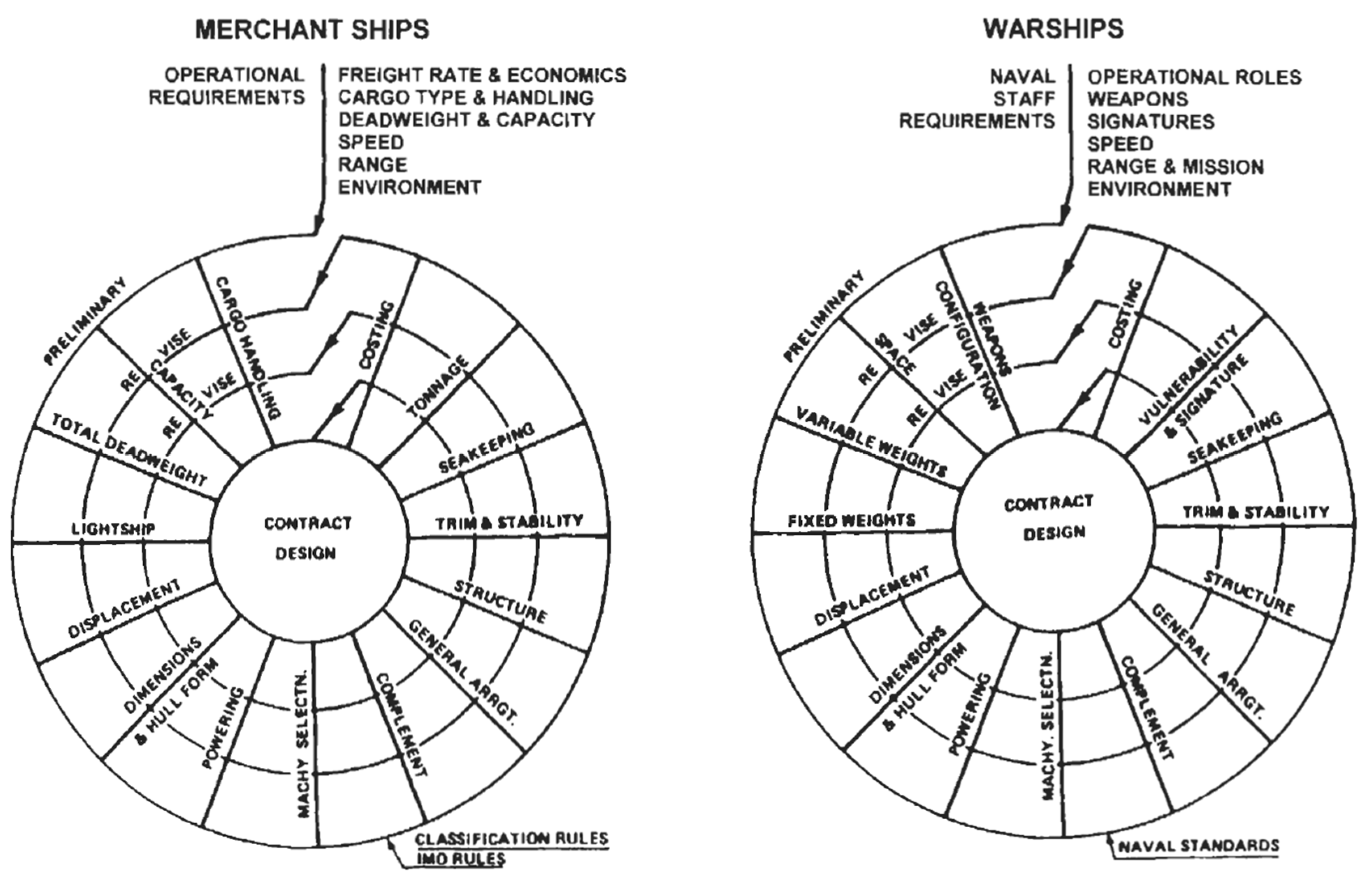
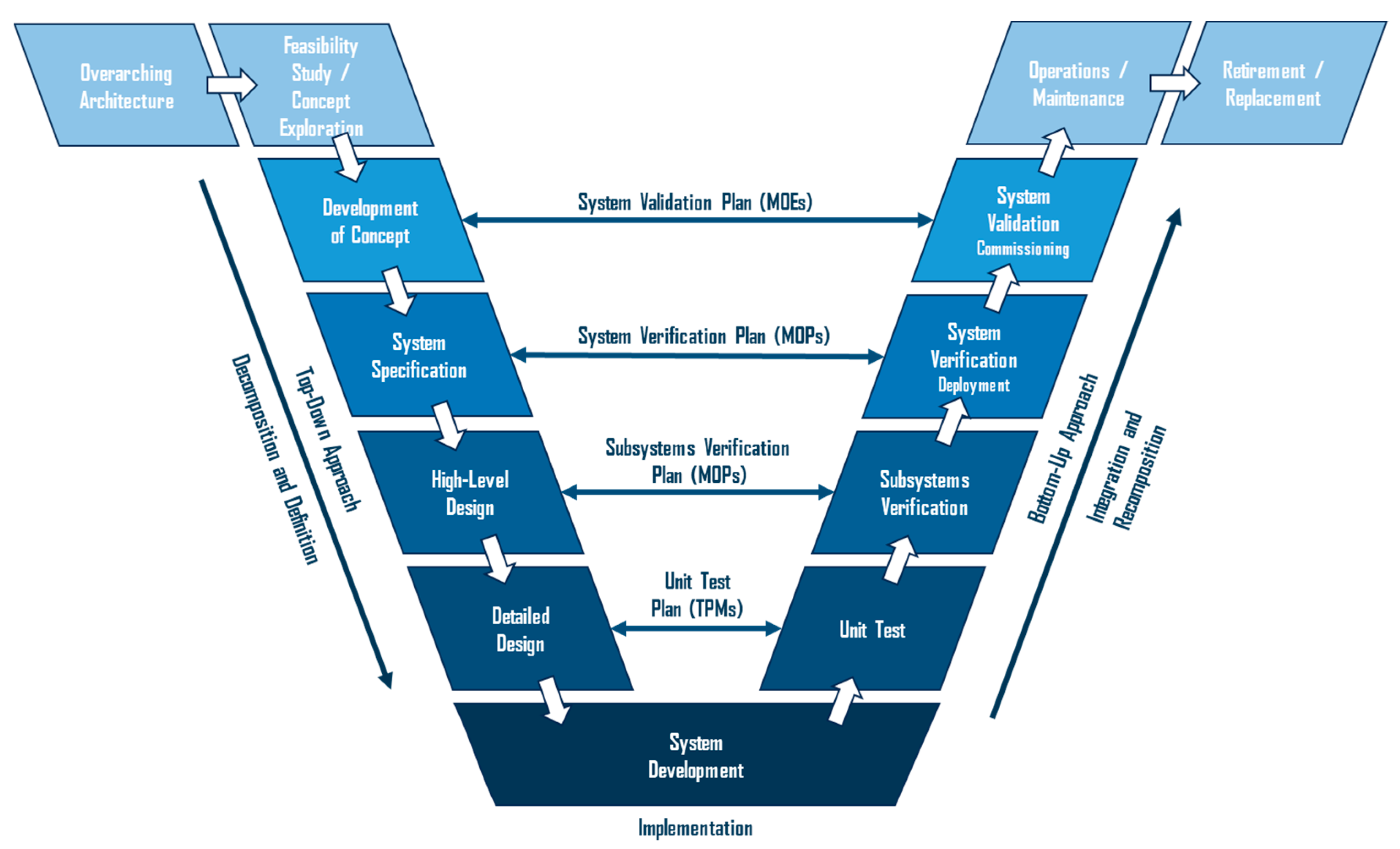
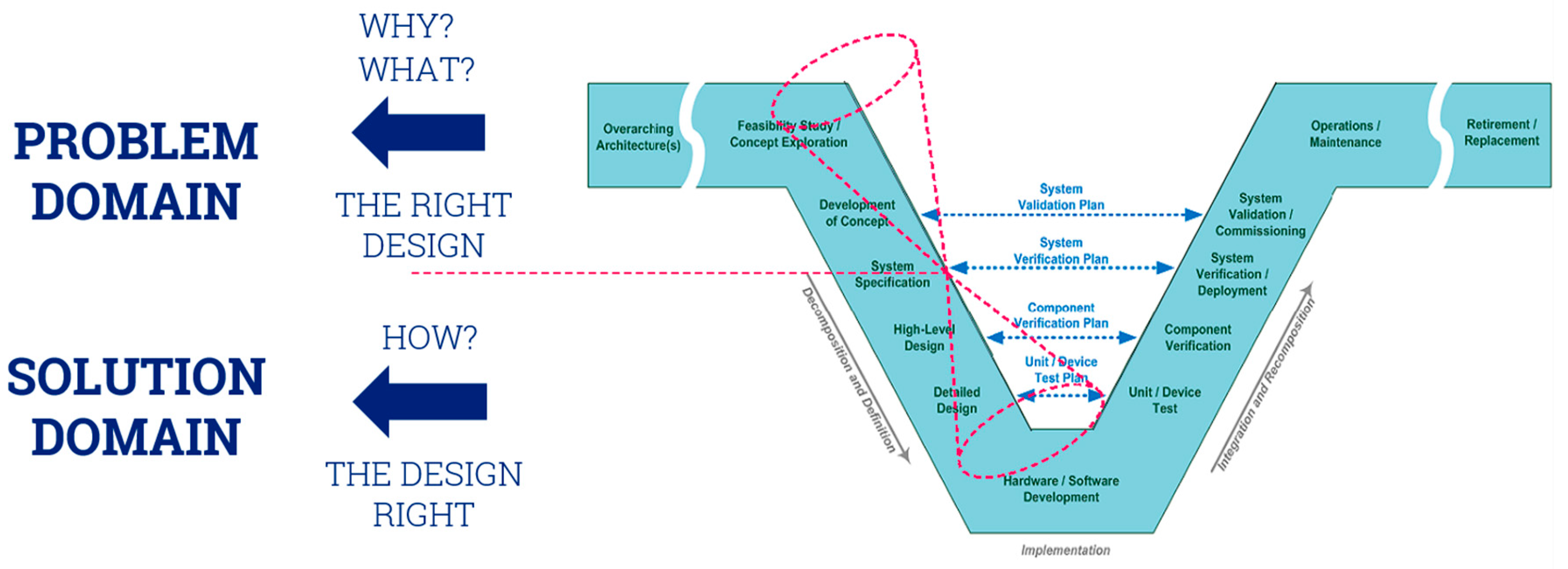

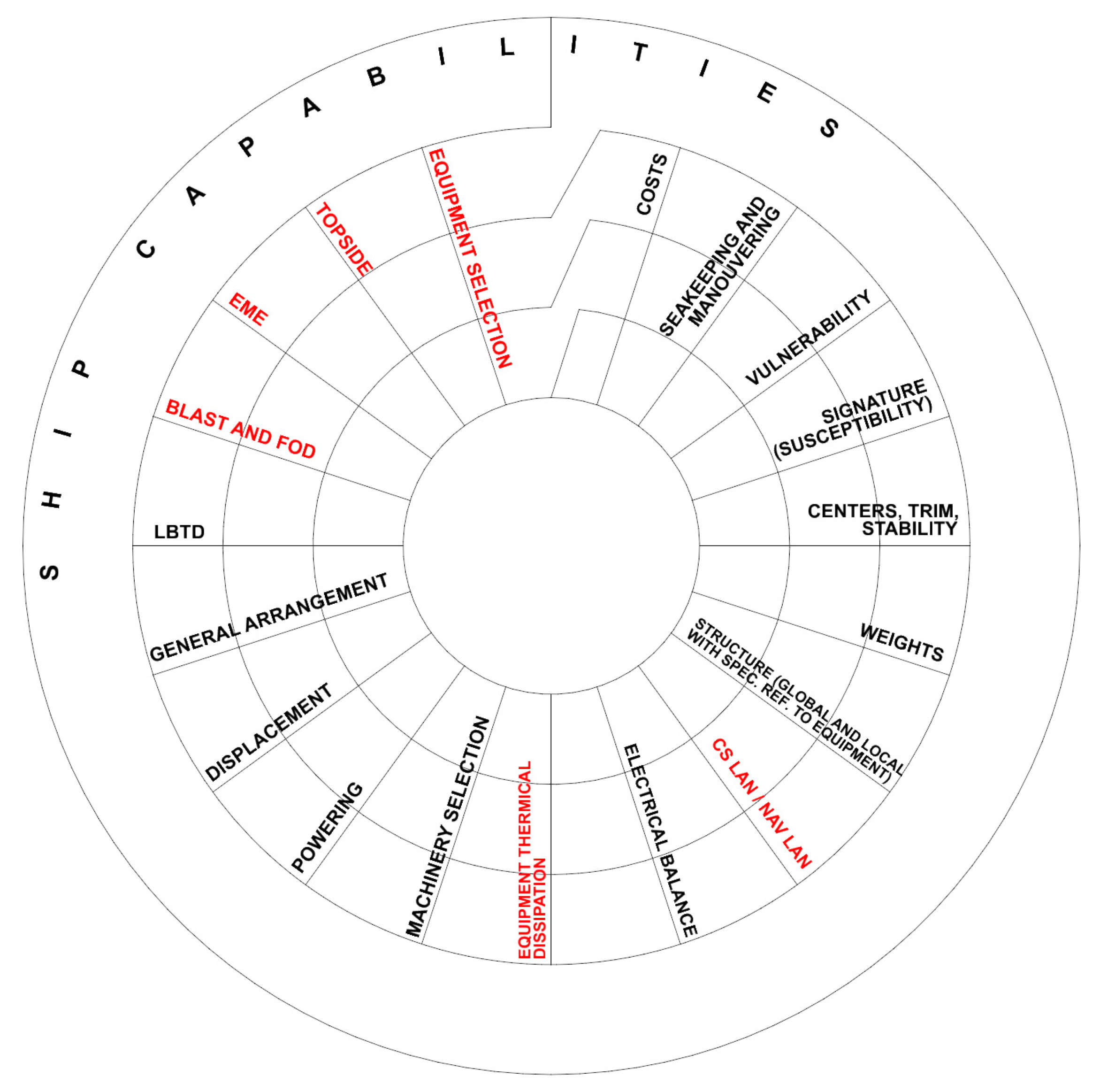
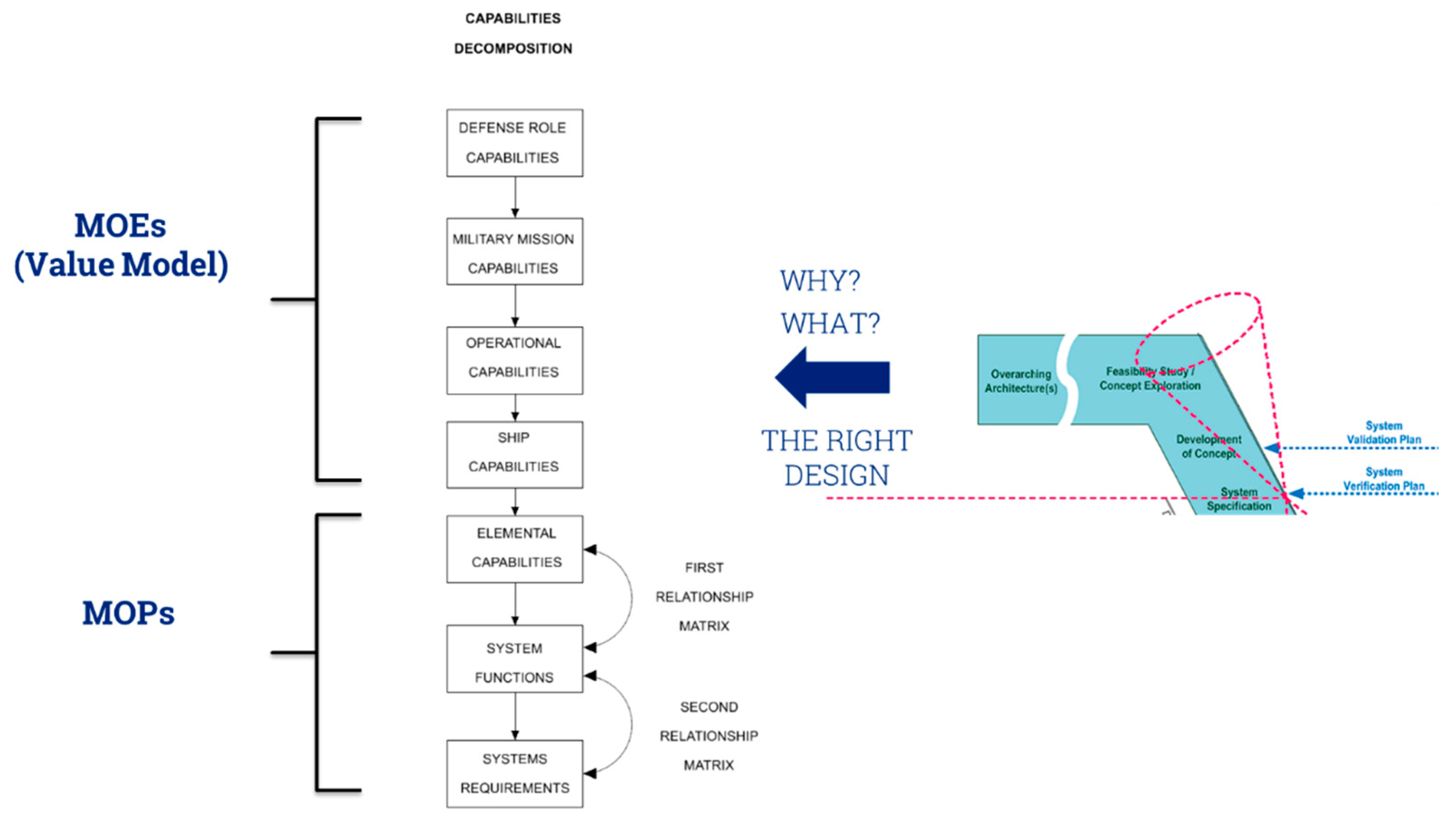
| Ship Domain | Ship Capability |
|---|---|
| Platform | Buoyancy |
| Stability | |
| Structural Strength | |
| Power Generation | |
| Controllability | |
| Communications (internal) | |
| Payload | Navigation |
| Command and Control | |
| Communications (external) | |
| Surveillance | |
| Combat |
Disclaimer/Publisher’s Note: The statements, opinions and data contained in all publications are solely those of the individual author(s) and contributor(s) and not of MDPI and/or the editor(s). MDPI and/or the editor(s) disclaim responsibility for any injury to people or property resulting from any ideas, methods, instructions or products referred to in the content. |
© 2024 by the authors. Licensee MDPI, Basel, Switzerland. This article is an open access article distributed under the terms and conditions of the Creative Commons Attribution (CC BY) license (https://creativecommons.org/licenses/by/4.0/).
Share and Cite
Bottero, M.; Gualeni, P. Systems Engineering for Naval Ship Design Evolution. J. Mar. Sci. Eng. 2024, 12, 210. https://doi.org/10.3390/jmse12020210
Bottero M, Gualeni P. Systems Engineering for Naval Ship Design Evolution. Journal of Marine Science and Engineering. 2024; 12(2):210. https://doi.org/10.3390/jmse12020210
Chicago/Turabian StyleBottero, Mattia, and Paola Gualeni. 2024. "Systems Engineering for Naval Ship Design Evolution" Journal of Marine Science and Engineering 12, no. 2: 210. https://doi.org/10.3390/jmse12020210







